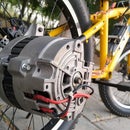Introduction: DIY Bladeless Fan From Scratch
The day I came across a bladeless fan, I was very fancicated by how simple and cool that Idea behind a bladeless fan is.
That same day I decided to built one for my nephew so that he wont hurt himself while having cold breeze during hot summer days.
So, In this instructable I am going to built a bladeless fan using very common material such as a bunch of PVC pipes, a plastic bowl and some fibre glass sheet. The best part about this bladeless fan is that unlike most of the DIY bladeless fans built out there I am going to keep this project accessible to all of you without including the need of 3D printing any body parts. This also makes the project to complete under 10 USD.
This project is sponsored by JLCPCB so have a look at their website as these guys are offering some great quality PCBs at dirt cheap prices.
Free Shipping on First Order & $2 PCB Prototype on
If you like this project then don't forget to vote me in the contests.
So without any further delay lets get building....
Step 1: Required Materials and Tools
The tools and materials required for this project are easily avaliable. The material required for this project is a bunch of PVC pipes measuring 6,5,and 3.5 inch in diameter , a plastic bowl and a 3mm sheet of fibre glass etc.
There is no need of a 3d printer as used in most of the DIY bladeless fan projects out there. Moreover I have used a miter saw to make most of the cuts as it made the job a bit accurate and easier but the same job can be done by using a handsaw and some patience..... so need of expensive tools to make a neat bladeless fan.
Step 2: Working Principle
As contrast to the name of the device being a bladeless fan, that thing actually have a rather high speed blade inside its main enclosure.
Besides that a bladeless fan offers an enclosed operation of blade and the air flow is then directed through a closed channeled body replicating the structure of a usual fan casing with the abscense of blades. This design offers great level of protection for kids.
Step 3: Making the
To begin with I started by making the main body and for that I am going to use PVC Pipe.
The main outlet is made of 6 inch diameter PVC pipe which is cut 4 inch wide to form the outer casing of the air outlet enclosure.
To form an air pocket inside the main air outlet I have used a tapered shape bowl that fits the 6 inch PVC pipe perfectly with its collar sitting on the edges of the pipe. So I cut the bowl from 1 inch above its bottom so that it forms a nice tapered collar inside the main outlet housing which allows the air to rotate inside the outlet cavity uniformly before leaving it.
Step 4: Inner Collar and Base
The inner collar for the air outlet is made out of a 5 inch diameter PVC pipe. This pipe forms a narrow opening that is nearly 0.5 inch wide for the air to uniformly spread out of the cavity/ air outlet. The three parts namely the outer 6 inch PVC pipe, the tapered inner casing made out of plastic bowl and the inner collar made out of 5 inch PVC pipe together forms the air outlet housing.
To form the base I have used a 3.5inch PVC pipe cut down to 5 inch height. To make the base perfectly fit the air outlet housing I have cut down one end of the base pipe in curved shape which I have traced by using some electrical tape and the outline marked with the 6 inch PVC pipe. The pipe is then cut down using a jig saw and then sanded using a sand paper to perfectly fit the outer 6 inch pipe without any gaps in between.
Step 5: Air Inlet Hole
Before gluing the base to the main housing I have drilled a 3 inch diameter hole in the 6 inch PVC pipe which will act as the passage for the air to enter into the main housing/air outlet. The hole is made using a hole saw.
The base is then glued to the outer part of the air outlet using super glue. Since the base pipe is perfectly shaped to sit on the 6 inch PVC pipe so the super glue made a very strong joint between the two pieces.
Step 6: Air Outlet Ring
The ring for the air outlet is made using a 3 mm thick fibre glass sheet which serves as a joint between the inner half and the outer half of the main Air outlet.
The ring is made using a jig saw.
Step 7: Painting
As most of the body parts are ready so i decided to give them a paint job to make them look neat and perfect. I painted everything white using a spray paint except of the fibre glass ring which is protected from paint using some electrical tape.
The end results are good and the blue fibre glass sheet just look fantastic on flawless white finish.
Step 8: LED Light Strip
To make the design more attractive and elegant I added a 12v LED light strip on the inner side of the air outlet at the end where the fibre glass sheet is going to be glued with the inner air outlet collar. The light strip is cut down to the required length. The strip offers a sticky back on removing the protective coating from the rear side of the strip and later sticking it to the PVC housing.
This way when I power up the fan the LED strip illuminates the rear side of the air outlet and thus producing a very cool effect on the front end spreading blue light.
Step 9: Gluing All Parts
As the pain dried I started gluing all the parts together to form the main body of our baldeless fan using super glue that seems to hold everything firmly.
Step 10: Mounting the Fan
Well behind every bladeless fan there is actually a fan with blades :P
So to power this bladeless fan I am going to use a 12v DC high speed fan that I have got from old computer scrap. More specifically that is a server fan which is way more powerful than a usual PC fan So I would highly recommend you using this type of fan.
The fan is mounted inside the base just beneath the air outlet housing using four wood screws to hold the fan firmly in place. The fan is mounted such that to force the air in upward direction and thus we need the fan to have quiet a bit of extra muscle.
Step 11: Air Inlet
A pair of air inlet are made just below the server fan on both side of the base pipe. These inlet holes are going to allow the air to be sucked inside the base.
To prevent someone to accidentally hurt fingers by inserting his/her fingers into the base of the fan, I have glued metal net on both the inlets. The net is first painted matt black and then glued front inside the base using hot glue.
Step 12: The Speed Control Unit
As I was just finishing up the project I decided to go with the idea of using PWM speed controller to this fan so that I can regulate the amount of air coming out of the fan and thus the noice levels too.
To do so I have designed a simple PWM speed controller circuit and also a dedicated PCB using autocad eagle. Learning to design schematic and later designing a PCB was made easy by instructables Basic Electronics and PCB Design classes. So have a look at these well described useful lessons.
The circuit works on a basic principal. It uses a 555 timer IC which switches a transistor several times during each second and the switching speed depends on the resistance provided by the potentiometer. Thus by turning the knob of the pot we can regulate the with of the out pulse and thus controlling the speed of the server fan.
I am attaching all the data including schematic, bill of materials and gerber files for the PWM circuit which might be needed to get one ordered from the website.
Besides that take a look at the JLCPCB as they are offering a great offer on your first order, so you can order 10 PCB including free shipment under just 2 USD.
After soldering all the components on the PCB I have counted the PCB on the front side of the base with the knob of the potentiometer popping out of the front side with a nice knob attached to regulate the speed of the fan.
Attachments
Step 13: Base Plate
To finish up everything I have hot glued the circuit on the base. Later I have cut down a fiber glass sheet and then screwed it to the base of the fan using two wooden blocks glued inside the base.
To stop fan from moving here and there while operating, I have glued four rubber pads to the base.
The fan is ready to roll....
Step 14: End Results
This project went fabulous. At the start I was puzzeled to built the proper enclosure without using a 3d printed part but as I rolled down with the project everything seems to perfectly fit with one another and for sure that plastic bowl made the job done perfectly.
The end results are pretty awesome considering the fact that using some of the very limited tools and commonly available hardware I ended up with almost piece of perfection..... Yes a DIY Bladeless Fan ....
Any suggestions are more than welcome, besides that have a look at the built video of this project on my youtube channel and don't forget to subscribe to my channel for more upcoming projects.
Till then have fun building and learning some awesome stuff at Instructables.
Regards.
DIY King





